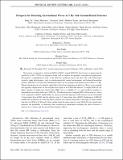Prospects for Detecting Gravitational Waves at 5 Hz with Ground-Based Detectors
Author(s)
Barr, Bryan; Hammond, Giles; Hild, Stefan; Hough, James; Huttner, Sabina; Rowan, Sheila; Sorazu, Borja; Carbone, Ludovico; Freise, Andreas; Mow-Lowry, Conor; Dooley, Katherine L.; Fulda, Paul; Grote, Hartmut; Sigg, Daniel; Yu, Hang; Martynov, Denis; Vitale, Salvatore; Evans, Matthew J; Shoemaker, David H; ... Show more Show less
DownloadPhysRevLett.120.141102.pdf (582.5Kb)
PUBLISHER_POLICY
Publisher Policy
Article is made available in accordance with the publisher's policy and may be subject to US copyright law. Please refer to the publisher's site for terms of use.
Terms of use
Metadata
Show full item recordAbstract
We propose an upgrade to Advanced LIGO (aLIGO), named LIGO-LF, that focuses on improving the sensitivity in the 5–30 Hz low-frequency band, and we explore the upgrade’s astrophysical applications. We present a comprehensive study of the detector’s technical noises and show that with technologies currently under development, such as interferometrically sensed seismometers and balanced-homodyne readout, LIGO-LF can reach the fundamental limits set by quantum and thermal noises down to 5 Hz. These technologies are also directly applicable to the future generation of detectors. We go on to consider this upgrade’s implications for the astrophysical output of an aLIGO-like detector. A single LIGO-LF can detect mergers of stellar-mass black holes (BHs) out to a redshift of z≃6 and would be sensitive to intermediate-mass black holes up to 2000 M_{⊙}. The detection rate of merging BHs will increase by a factor of 18 compared to aLIGO. Additionally, for a given source the chirp mass and total mass can be constrained 2 times better than aLIGO and the effective spin 3–5 times better than aLIGO. Furthermore, LIGO-LF enables the localization of coalescing binary neutron stars with an uncertainty solid angle 10 times smaller than that of aLIGO at 30 Hz and 4 times smaller when the entire signal is used. LIGO-LF also significantly enhances the probability of detecting other astrophysical phenomena including the tidal excitation of neutron star r modes and the gravitational memory effects.
Date issued
2018-04Department
Massachusetts Institute of Technology. Department of Physics; LIGO (Observatory : Massachusetts Institute of Technology); MIT Kavli Institute for Astrophysics and Space ResearchJournal
Physical Review Letters
Publisher
American Physical Society
Citation
Yu, Hang et al. "Prospects for Detecting Gravitational Waves at 5 Hz with Ground-Based Detectors." Physical Review Letters 120, 14 (April 2018): 141102 © 2018 American Physical Society
Version: Final published version
ISSN
0031-9007
1079-7114